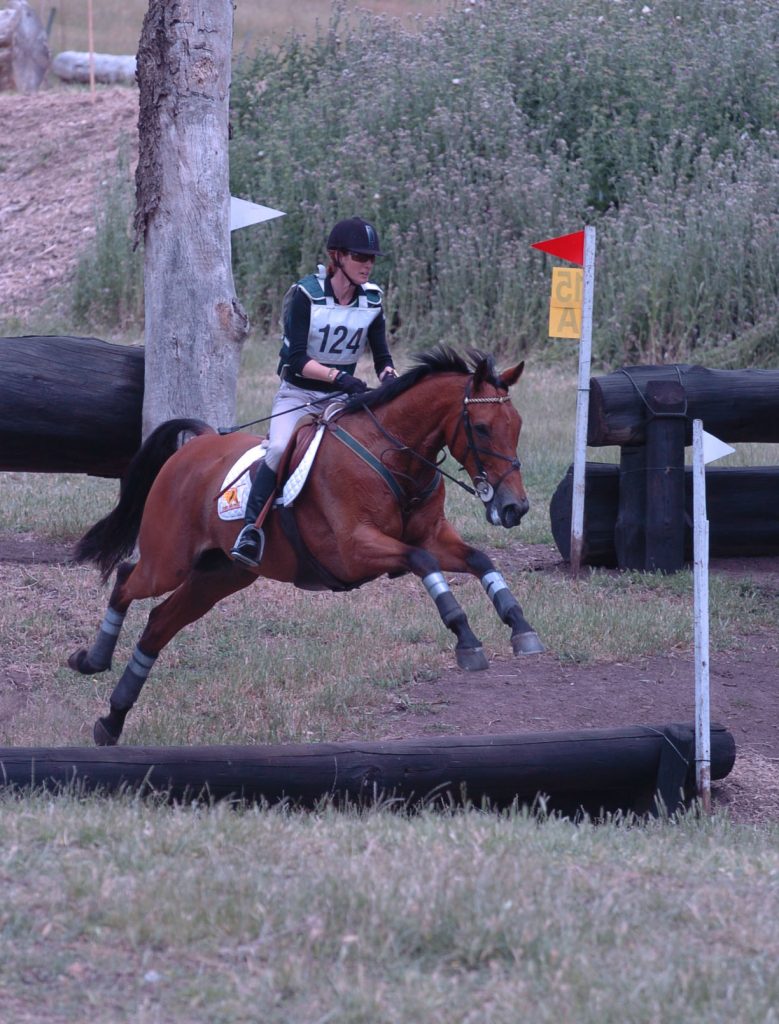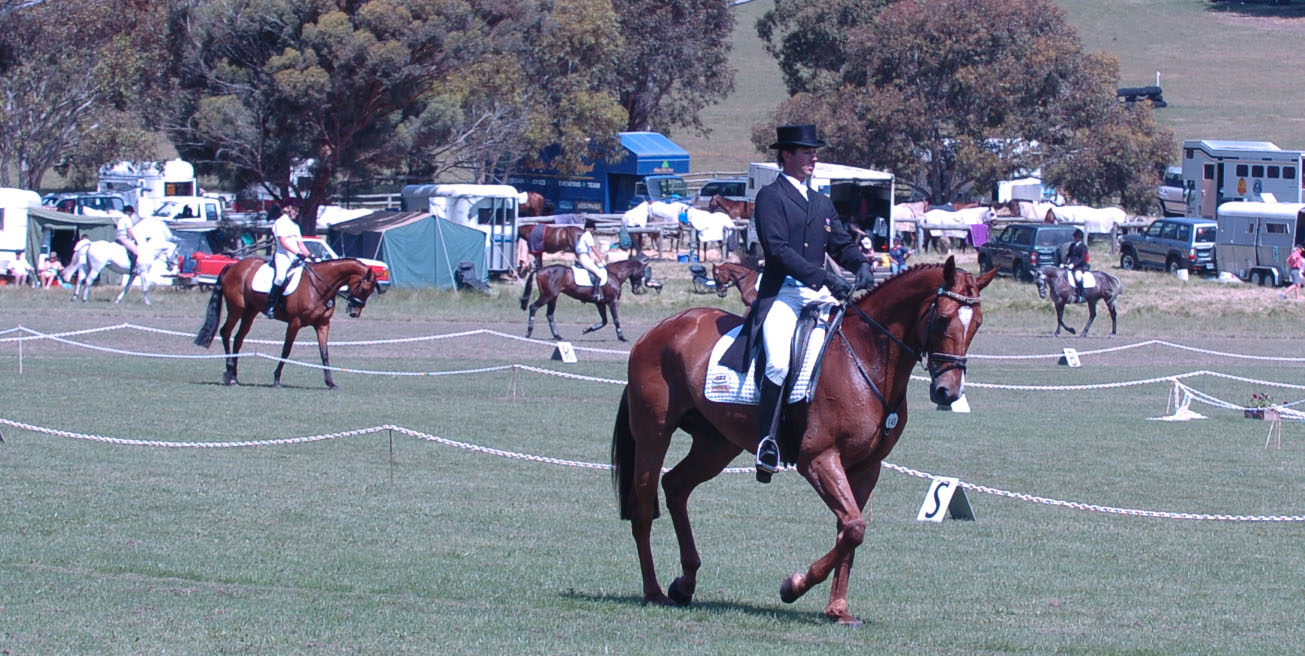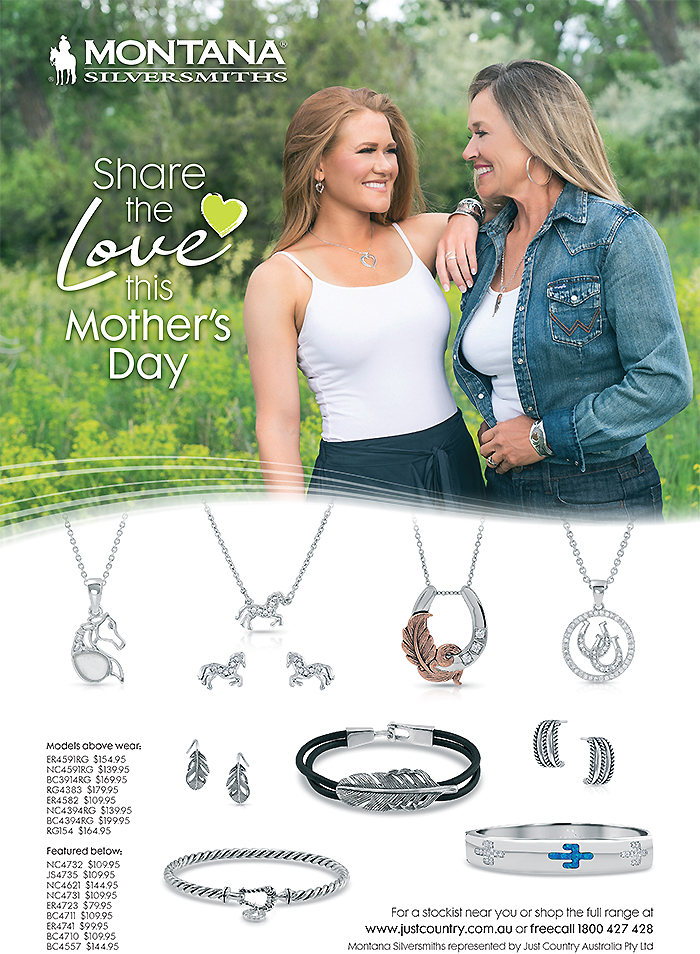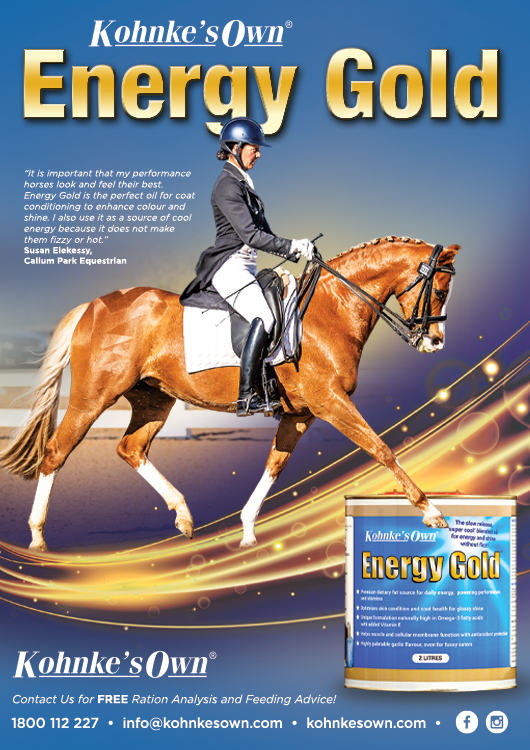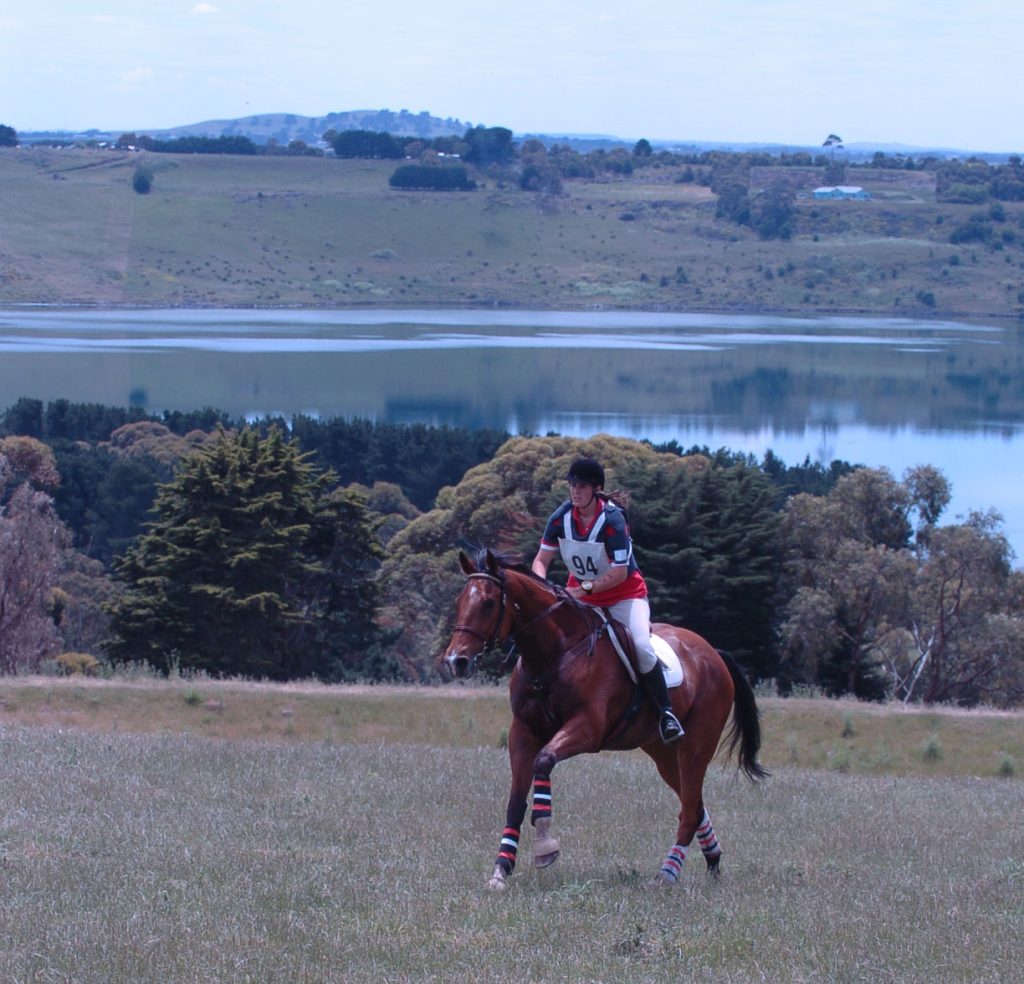Mary Wanless changed the way the riding world looked at the mechanics of riding. In this article she applies her knowledge to the problems faced by the dressage rider and the eventing rider… with some very interesting conclusions!
THE POWER OF CONCENTRATION
Sports in which speed and danger are major ingredients present very different challenges from those which require calmness during periods of inactivity (snooker and golf, for instance), or within activities that are slow, precise, and which pose no danger. Most people have a preference for one particular type, and this influences their choice of equestrian discipline. But the rider who chooses eventing has to deal with extremes: the speed and danger of cross country, and the slowness and precision of dressage.
Very few people concentrate well both when they are moving fast and when they are moving slowly, and competition stress often increases the discrepancy. Those who love the challenge of riding at speed often meet their Waterloo in the dressage arena because there is so much time that this invites them to worry about factors that are actually irrelevant.
Others find that once they are in a dressage test, the corners seem to come towards them very much faster than they do when working in the same size arena at home! This discrepancy is not a measure of how fast the horse is travelling: it is a measure of the debilitating effect that competition stress has on the rider’s concentration, and thus on her performance.
One young, up-and-coming event rider talked with me recently, contrasting his experience of both phases. During a dressage test, he was worrying about what the judge was thinking, what everyone would say, whether he was going to make a fool of himself, etc. etc. He noticed every little distraction around the dressage arena – which of course, his horse did too. But in contrast, he went across country feeling as if he was riding down a tunnel in which only he, his horse, and the jumps existed. He was unaware of spectators, or of distractions. If someone had let off a bomb nearby he would probably not have noticed – a sure sign of quality concentration.
Cross country riding is the ultimate “kill or cure” situation, in which there is no time for dithering, and little time for conscious thought. But dressage invites you to think the worst about yourself and your performance, and this can only happen because the price of a mistake in the dressage arena is actually so low.
In cross country riding it could be death, and death is undoubtedly a very powerful motivator: one thinks “Not that!” and bounces away from it into a state where it is obviously vital to pull oneself together. But at the thought of looking stupid in a dressage arena, the “Not that!” is nowhere near so powerful. Many sports psychologists have concluded people in general are much more immobilised by the thought of looking stupid than they are by the thought of injury, and I suspect that this may be true of many event riders. But if it is true of you, what can you do as first aid? You can only stop worrying about the judge, about distractions, and about what you are bound to do wrong, when you have somewhere else to put your attention instead somewhere that is equally or preferably more compelling.
Furthermore, the alternative will only become compelling if it is very concrete, and if it works for you, yielding such obvious results that you learn to trust it.
The successful dressage rider is always paying attention to two interrelating levels of feedback. The first concerns her body, and the second concerns her horse’s carriage and movement. She perceives both of these kinesthetically ie. through her feel sense and not visually – this means that she is not looking at her horse’s ears to make sure that his head is in the right position!
This is one of the most common mistakes that event riders make, and it is extremely debilitating, for it undermines the body’s ability to perceive feelings. (If you have a problem with feel, close your eyes when you are riding, and when you open them again make sure that they remain defocussed; that way you can still tune in to your feel sense without allowing visual input to over-ride it.) Another problem arises whenever your attention is drawn to your hand and the rein contact, rather than to your pelvic area and its contact with the horse’s back. To the untrained brain and backside this is much less obvious – after all, we spend much of our lives using our hands to manipulate the world, and the body automatically expects that they will be equally effective on horses.
story continues below the advertisement
If you took one hundred percent of your attention and divided it into two parts, what percentage would be focused on the hand, the rein contact and the position of the horse’s head, and what percentage would be focussed on your pelvic, abdominal, and thigh area, and its contact with the horse’s back? (Answer this now before you read on.)
Most people confess to having seventy or eighty percent of their attention on their hand and his head, but I believe that in dressage, learning only really begins when we have at least eighty percent of our attention focussed on the pelvic area. (Realise too that in asking you this I am ignoring any percentage of attention frittered away on external distractions!)
To become skillful at dressage we have to become “dexterous” with the pelvis, for it is here that one learns to recognize ‘right’, and to intervene when necessary – influencing the horse’s back rather than his head. The ability to make discriminations and adjustments through one’s pelvic positioning provides the alternative to worrying, dithering, pulling the horse’s head down, or simply kicking him harder in the ribs.
Jumping provides much more obvious focus of attention, which is now external. Since there is an element of danger involved it also encourages high quality concentration – especially when the fences do not fall down! But when they do, there can still be problems. One very successful event rider told me recently about the difficulties he had riding showjumps, especially when the pressure was on. He would always mis-time at least one, meet it on a wrong stride, and hit it. He was in a dilemma: should he go out and jump really big tracks, so that show jumping became the same “kill or cure” challenge that brought out the best in him cross country, or should he analyse his technique, find out what he was doing wrong, and correct it.
Interestingly, these two options are diametrically opposite, the first requiring less use of the conscious mind, and the second requiring more. I suspected that jumping big tracks might not work well for him in the longer term. I know many riders who jump well when faced with a big challenge, but as soon as smaller fences offer them the opportunity to dither, they do so. It is as if the situation becomes a “coat hanger” for other fears which do not really belong to it – and which do not surface if the actual here-and-now danger is great enough. This left the choice of analysing his technique: this, I felt, could work, as long as he found the right component parts that he needed to pay attention to.
If you have not grasped the “whole” of either dressage riding or jumping, then I suspect that you have no choice but to come to terms with the parts. But the parts themselves are crucial. Think of riding as a pie that has traditionally been cut into certain pieces – like “sit up straight and push your heels down”. If these pieces really were cornerstones of a talented rider’s skill, then doing them would enable us all to consistently achieve the same results as the very best riders. Most people assume that talent lies in what you’ve got, but I believe that it lies in what you do with what you’ve got- a premise that has consistently been borne out for me in my work with riders of many different shapes, sizes, and temperaments.
I cut the “pie” of riding into some rather unusual pieces. These have become apparent to me during twelve years of research during which I have tried to find out what good riders really do to achieve such spectacular results. One of the most fundamental pieces which is vital in both dressage and jumping is “bearing down”.
Try it now as you sit in your chair. Put one hand over your solar plexus just beneath your sternum, and (please forgive my crudeness) imagine that you were sitting on a toilet and about to pass your daily motion. What happens to the muscles underneath your hand? You should feel them press outwards against your hand, and the muscles of the lower abdomen should press out too. If you touch the back muscles which lie on either side of your spine you should feel them press out as well.
Learning to use your front is the first step towards learning to use your back. All good riders do this, but the vast majority do not know that they do it. (Interestingly, the more natural talent someone has, the more likely they are to be inaccurate in their verbal descriptions of how they do what they do.) So this fundamental piece has never become a part of our understanding of how riding works.
My experience suggests that breaking any skill – including riding – into the most appropriate component pieces makes a phenomenal difference to its learn-ability. Talent is nothing more than the grasping of these vital pieces: it requires the discipline of high quality concentration, and a precise understanding of exactly what area one needs to be concentrating on. When the rider has this, jumping ceases to be frightening, and dressage riding ceases to be paralysing.
(Article continues below)
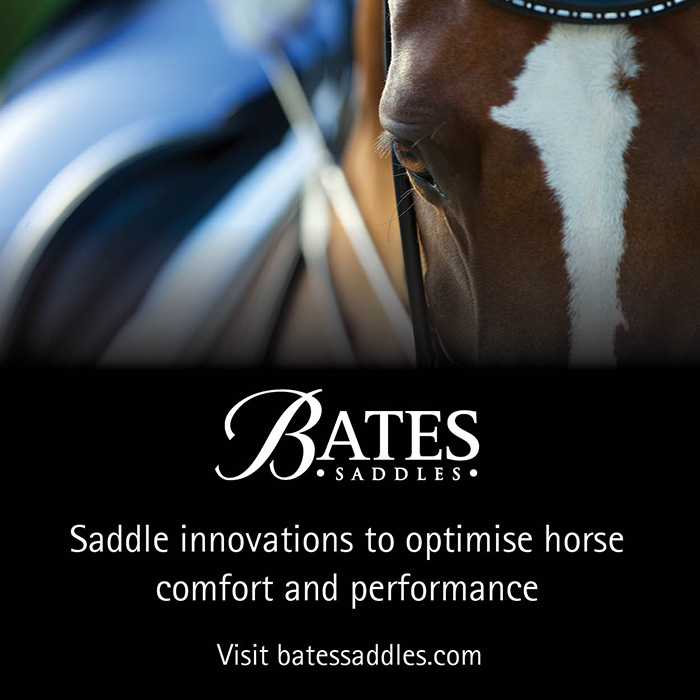
THE FOCUS OF ATTENTION
The ability to concentrate whilst riding both at speed and in slowness is something that few riders possess. As well as this, some find it easier to concentrate on an internal focus of attention, whilst others prefer an external focus. This is so much a part of our personality that it underlies each rider’s choice for her chosen equestrian discipline, and the exponents of the various skills tend to be very different types of people.
But the event rider is forced to deal with the demands of three very different riding styles – and her preferred focus of attention is one of the factors which makes it so difficult to excel at all of them. Polo provides the extreme example of an external focus: the rider’s body must be left to react on “automatic pilot” whilst she pays attention to the changing world around her.
A set series of jumps provides a more predictable external focus, but again, the rider’s attention is needed outside herself, and previous training through grids etc. builds reliance on a series of bodily responses which will, hopefully, function automatically under the pressures of competition.
Dressage riding provides the most extreme example of an internal focus of attention: the rider pays attention to her body and the feel of the horse underneath her, and externally she need only be aware of her changing location in a world which remains completely unchanged.
I propose that event riders (and probably all jumping riders) are rarely good at sustaining an internal focus of attention. All too often dressage – with its internal focus – becomes their downfall, and their difficulties are compounded by another variable: the fact that they prefer to pay attention to wholes rather than to parts. I was working recently with an older woman who had been an international event rider in her day, and who was renowned for her attacking riding and her ability to stay in the saddle whatever happened. But despite very classical teaching, she had never felt that she liked or understood dressage.
During several lessons I drew her awareness to different parts of her body: I taught her “bearing down” – the use of the abdominal muscles which I explained in the “power of concentration” article. Then I taught her “the pinch feeling”. To learn this now, stand with your knees slightly bent, and find the bony projection at the top outside of each thigh (the greater trochanter of the femur). Then imagine that there is a bolt through you at this point, and, that somebody is tightening up the nut, drawing the two sides of you in closer together. Feel how this changes the angle of the pelvis, bringing it forward.
Feel too how the buttock muscles tighten a little, and how the thigh changes shape. Good riders sustain this pelvic angle and this level of muscle tone all the time. These two pieces are, I believe, two core elements of the rider’s skill – the fundamental building blocks that everything else depends on. All good riders do them, but do them so automatically that they rarely know that they do them – and as a result, they cannot talk about them.
These interventions, along with some others, gave my pupil the stability and precision that she had previously lacked with her stirrups at dressage length, and this in tum had a profound effect on her horse’s carriage.
At the end of our lessons, she was aware of her improvement as I was. For “homework” I suggested that she kept thinking about these pieces, whether she was schooling or doing fittening work. In response, she sighed, looked at me rather ruefully, and said “I think you’ve just spoilt riding for me.”
My pupil’s increased skill came at a price – namely the loss of the instinctive pleasure that she felt when she left her body to function on “automatic pilot”. Like all bold, skillful jumping riders, she had grasped the “whole” of jumping very easily, and was a master of the rider’s split-second reaction as the horse takes off for a fence. But she had not grasped the equivalent whole of dressage riding.
The improvement in her flatwork became possible because I gave her information in “bite size chunks”. I believe that many aspiring students of dressage fail in their learning because they are given pieces which are too big to digest, even though their natural preference might be for larger pieces.
‘Sit still’, ‘Flex the horse to the right’, and ‘Keep him on the bit’, for instance, are not ‘bite size chunks’ for many riders, not unless they already have natural talent. This is another way of saying that their body instinctively knows the A, B, Cs of riding – the basic building blocks which other riders have to learn.
Skilled jumping riders are inclined to trust their automatic responses and to ride ‘by the seat of their pants’. As a result, many are reluctant to focus inward and to learn (or more accurately, to re-learn) the ‘parts’ of dressage riding.
Those who prefer flatwork do so because they find ‘parts’ easier to digest than ‘wholes’ – and they get their security from knowing that they have each little step right before they go on to the next. But everything in jumping happens so fast that it is not so easy to learn in a step-by-step manner. To make it worse, there is very little time to rectify mistakes.
story continues below the advertisement
Whatever the rider’s preferred way of learning and of focusing her attention, she will only develop her skill in each discipline as she becomes casual. When she is reactive she feels that events – be they the jump, or the movements of a dressage test – happen to her, speeding by without her really being able to intervene and direct their course. This loss of control is a sure sign of poor concentration, and the rider will only become casual when she discovers firstly how to concentrate, and secondly what to concentrate on.
It is through this that she improves her technique, for smaller and smaller differences gradually come into her awareness. Learning is the process by which a rider’s responses become more and more refined. One benefit, for instance, is the ability to ride a small half-halt just as the horse begins to lose balance, rather than a very crude one, once he is already well and truly on his forehand. The first rider, although she intervenes much more quickly, always appears to have plenty of time and she has a much smoother rider than the second.
During gridwork sessions I help riders who need to improve their technique by asking them to rate their perceptions out of ten each time they go through the grid. A ten out of ten means that they felt whatever happened – whether it be a loss of stability in their lower leg, a hand which did not free enough, a horse that jumped crooked, or all three.
So a ten does not imply perfect riding – instead it implies high quality concentration. Another rider might go through the grid showing better style, but with much less awareness of what happened. My principle here is that until the rider actually perceives what is going wrong, she has no chance at all of correcting her mistakes. With her perceptions on two or three out of ten, her trainer’s words fall on deaf ears, and she is very badly equipped to face the increased stress of competition.
Riders who give every appearance of being deaf have consistently told me that the underlying problem lies in their perception of time, and the jump seems to whiz by so fast that they do not know what has hit them! In this situation, how can they possibly make a position correction? They are (in popular terminology) “out to lunch”.
In contrast, jumping riders who are causal have the delightful experience of feeling as if everything happens in slow motion, giving them plenty of time to make adjustments to their own body position and their horse’s balance, and to make a turn.
Top class riders are separated from the average performer by the clarity of their perceptions and by the way that they ‘control’ time. Unfortunately these skilled riders do not usually realise quite how profound this difference is, and in their teaching they often make the mistake of assuming that the student is just as able to make corrections as they are.
Then I have talked to these riders about the experience of less ‘talented’, more reactive riders – who are struggling to feel that they have any influence at all – the skillful riders have typically responded by asking me, “If they feel like that, why do they do it? I certainly wouldn’t if I felt that way…”
Interestingly, I have heard almost exactly the same words from good dressage riders and good jumping riders. In each camp, the riders who are causal have absolutely no idea of how the other half (or more accurately, the other ninety percent) lives.
There is a colossal loss of perceptive power when time goes by so fast that the rider does not know what has hit her, or so slowly that attention is lost in worrying. The first can happen both in jumping rings and in dressage arenas, the second is the agony that many people think of as “dressage”. In both disciplines, no learning can take place until the rider’s attention is focussed in the right place – whether this be more internal, as in dressage, or more external, as in jumping.
When the most important ‘ bite size chunks’ come together, the rider begins to influence not only her horse, but also her experience of time. It is this that makes her causal, and it is the basic stance that must be achieved before it is possible for her to excel.
story continues below the advertisement
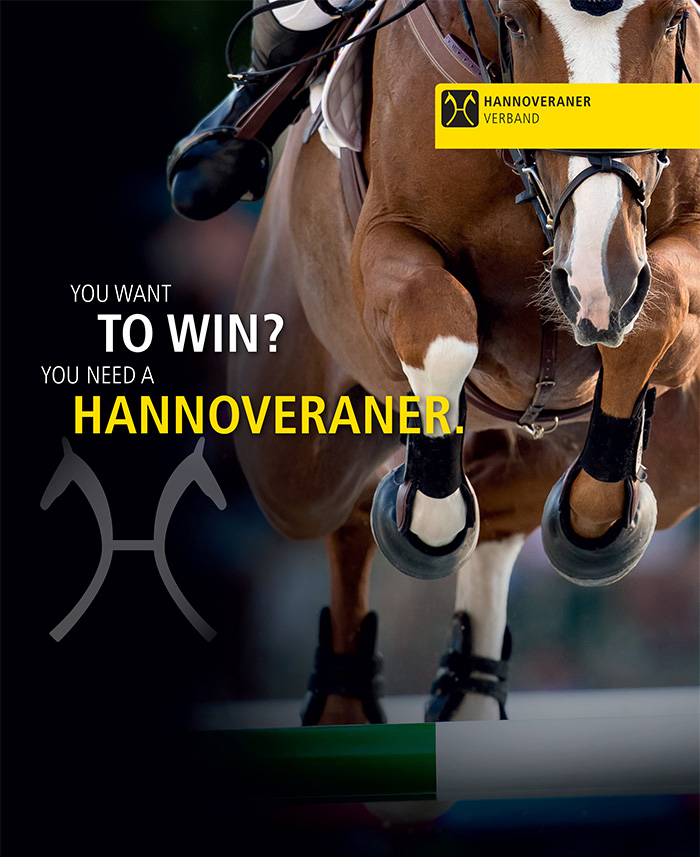
THE SMALL PIECES OF DRESSAGE
Balance over the stirrup
It is a well known fact that most riders have a preference for either jumping or flatwork, and that few excel in both. One important factor in this is each person’s preference for an internal or an external focus of attention, and her ability to hold concentration in slowness as well as speed – without the ‘kill or cure!’ ultimatum that makes cross country riding so compelling.
But on a more mundane level, few riders appreciate the differences in technique that are demanded by a change in stirrup length. If you stand in an “on horse” position with your knees slightly bent,you can feel how your weight is distributed over your feet, with the balls of the feet taking most of it. If you slowly fold down into jumping position you will feel that your weight gradually rolls back onto your heels. The fact that you have stayed in balance over your feet throughout this manoeuvre demonstrates that you have not lost responsibility for your body weight – this is important, because a loss of balance can endanger you and turn you into a burden that impairs your horse’s jumping style.
But look at this the other way round. The change in the weight bearing area (from primarily on the balls of the feet to primarily on the heels has demanded a total change in your body position – from the upright position of flatwork to the fold down that you show over fences. To me it seems amazing that this change in balance point, which is probably no more than seven or eight inches, can have such huge ramifications.
But very few riders demonstrate this change in balance so clearly when they are actually astride a horse, and the vast majority of riders I see are pushing their heel too far down and forward the upright position of in flatwork, whilst at the same time finding that it flies too far back and up when they are in flight over a fence.
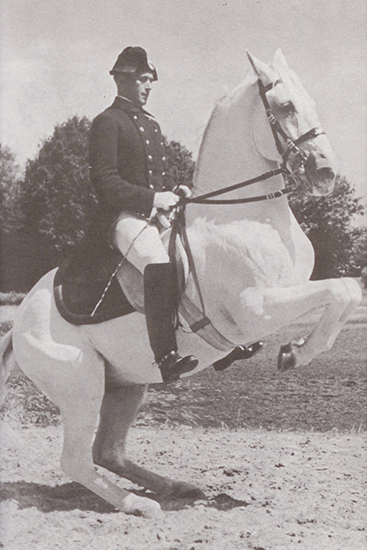
Think of photographs you have seen of riders from the Spanish Riding School, who show an exemplary flatwork position with a shoulder/hip/heel vertical line. Although we often hear this spoken about, it is much less often done: perhaps this is because there is an inherent contradiction between this idea and the concept of having the inside leg “on the girth”. It is impossible to do both at once, and most riders seem to opt for “on the girth”.
However, in flatwork riding I think this is a mistake – strictly speaking it is impossible, and the value of the term lies in the distinction that it makes between the positions of the inside and outside legs on a circle.
When I assess a rider’s flatwork balance, I ask myself two questions. The first is, “If I could whisk this rider’s horse out from underneath her by magic so that she dropped down onto the riding arena, how would she land on it?” Very often the answer is “on her backside”- as is inevitable if her upper body is upright and her lower leg is “on the girth”.
The classical rider with her shoulder/hip/heel line would land on her feet, and this tells us that she has maintained responsibility for her body weight (as does the correctly balanced jumping rider who has counter-balanced her leg position by folding from the hip).
The horse is then carrying a load which is in itself in balance: if you have ever carried a rucksack for any length of time you will know what a difference this makes.
Another question which effectively assesses the same thing is, “Would the rider balance on a diving board?” I am drawing an analogy here between the rider’s balance over the stirrup, and the balance of a diver who stands on the edge of a diving board about to do a backward dive. Note that the diver’s weight is carried on the balls of her feet as they rest on the edge of the diving board. It is not carried in her heels; in fact when she wants to dive off she pushes her heels down and forward – mimicking the position of the out-of-balance flatwork rider. Yet most riders are convinced that their weight should be carried in their heels even in dressage riding, and the idea that it should be carried over the stirrups appears revolutionary.
“Push your heels down” seems to be a golden rule which is unquestioned, and considered true regardless of context, and of its effects. It seems to me that our riding theories and teachers have not made a clear enough distinction between the flat work balance and the jumping balance.
In response to the down and forward heel it is natural for the body to fold into jumping position. But another response is possible, especially when the jumping rider has her stirrups at dressage length. All too easily she counter balances on the reins, using the pull she has created to stop herself from falling over backwards. (Paradoxically, this same rider may also have a very unstable lower leg over fences – she is out of balance in both situations.) The classical dressage rider who maintains her correctly aligned body also has a lowered heel: but she achieves this by bringing her heel down and back, balancing over the stirrup like a diver on a diving board.
In practise many riders find this extremely difficult at first. If they are not allowed to push the heel forward , they find that they cannot get it down at all. This is hardest for riders who cannot squat on the ground without their heels coming up off the floor – this shows that their calf muscles have shortened. (Wearing high heeled shoes for any length of time encourages this to happen, as does a tendency to walk slightly on tip-toe.) If they can get the sole ofthe foot flat this is a good beginning – it at least puts the calf muscles under tension, creating the same effect that a lowered heel has on longer muscles.
When the rider is in an “armchair seat”her weight is centred in the middle of the horse’s back, precisely in the point that is lowered when he hollows it. The image of the ‘mantrap” helps to explain this:you have probably seen old movies showing how explorers in the African jungle used to catch animals by digging a pit and covering it with branches. The hollow in the horse’s back is the pit, and the thigh is like one of the branches – except that in this case it does not extend all the way back over the pit. The rider’s weight is stacked up above the free end of the branch, and she will inevitably fall down the pit unless it is counter-balanced by weight acting down through the knee. The thigh then acts as a lever, and using it correctly places tremendous strain on the thigh muscles. Instead of being like sitting in an armchair, the riders position becomes much more like kneeling.
To understand how this works in rising trot think of the manually operated barriers that are used at the entrances to army camps. The free end rises and drops without ever crash-landing into its casing. This is because it is counter-balanced by a heavy weight just the other side of the supporting column where the barrier pivots.
When the rider is in an “arm chair seat” it is impossible to bring the horse correctly “onto the bit”, for as she falls down into the “mantrap” she unknowingly perpetuates the hollow in his back.
Meanwhile, she is probably over-using her hand, and worrying about the position of his head. This puts the horse into a horrible contortion: try hollowing your own back andpulling your chin in. Most horses will do their utmost to get out of this position, whilst the saintlyones “give in” and offer arather unconvincing imitation of dressage.
The truth is that correct head carriage comes on its own when the rider is able to draw the horse’s back up underneath her – hence my idea that the rider needs at least eighty percent of her attention in this area of her body.
The mechanics of the correct rider/horse inter-action can only work when she is ‘out of the mantrap’, with her body weight spread down her thigh and balanced over the ball of the foot. To gain sufficient body control she also needs the “bearing down” and “the pinch feeling”, which I have talked about earlier. In effect the horse’s back then comes up to the fill the space that is created as the rider’s thigh helps to support her body weight: her body acts almost like a suction device. This is as true on event horses as it is on dressage horses – in either field, there is no substitute for technically correct riding.
The small pieces of showjumping: An eye for a stride
I meet riders with varying attitudes to jumping, from those who cannot wait to leave the ground to those who are extremely reluctant. In between are those who flourish when doing grid work but who flounder when faced with a course, those who are happy only up to a certain height, and those who (although they love cross country riding) have a “thing” about show jumping.
It seems to me that there are several fears underlying these common worries.
The first is fear that comes from feeling insecure over the fence itself. This happens to riders who are reactive, and who experience the jump as happening so fast that they do no know what has hit them.Fortunately, most event riders have passed this stage, except perhaps when they meet the odd “rider frightener” – a difficult combination, a ditch or a drop.
One extremely skillful rider told me recently that although she had no fears about her own stability or about a particular type of fence, she did feel frightened at the thought of approaching a large jump in an unbalanced canter with her horse on his forehand. But this fear is extremely useful to her, because the canter is within her power to change: her fear becomes motivating, whereas being afraid of the jump itself tends to make fear become paralysing.
This difference is tremendously important: it is a significant factor in the divide that separates the skilled rider from the less effective one.
Many riders are afraid of arriving at a fence wrong. So much adrenalin is produced by the actual here-and-now danger of cross country riding that most transcend this fear; but in the show jumping arena it surfaces again, and a surprising number of event riders hate show jumping simply because of their worries about striding. It is obvious that the specialist show jumpers who canter so slowly and quietly up to a four foot six parallel do not have this problem!
The riders who have no qualms about striding do not think consciously about it, or count themselves down into fences. But whenever a rider is afraid of arriving “wrong” at a fence she tries to think out the striding consciously. The insecurity generated tends to produce either hesitation or over-riding: she finds herself wondering, “Will he stand back or won’t he? Shall I kick him on or shan’t I?”
The brain very often does not know how to get out of this dilemma, and has no other resources to call on. I have met many riders who thought that they lacked some innate talent and were stuck with this problem for life. A sense of defeat develops all too easily because the “Will he … won’t he” soon creates a self fulfilling prophecy. After a few occasions when the rider has demanded a big stand off, the horse may rush into his fences because he has already been rushed into a fence, and he is pre-empting the rider. Or if the rider has put the horse in a position where it was impossible for him to extract himself, he may become hesitant.
Either way, the trust between horse and rider diminishes – so the rider is even more inclined to think, “Will he … won’t he”, thus winding the spiral one stage tighter. The horse’s attention is taken away from relating to the fence, and is taken up by his worries about the rider. Given this, it is not surprising that he too makes mistakes.
It is very natural for you (on your feet) to be able to run down steps and across the pavement, to quickly assess the traffic, jump down the kerb into the road, run across it and up the kerb on the other side. You do not need to think about it consciously, and the only times you are likely to make a mistake are if you are panicking, or half asleep. Your eyes, your brain, and your legs have an inbuilt coordination which makes it all “just happen”.
So too does the horse – as long as he is neither snoozing or panicking, and as long as you do not interfere with it. When the rider begins to “look” for a stride, she holds the horse back with her hand, and interacts wrongly with his back. Although she may be aware of this (and of its consequences), she will not be aware of the accompanying change that happens with her vision.
I believe that the good riders look at the fences with their unfocussed vision, much as you look when driving a car. You do not stare at an upcoming drain cover, or at a tree – you keep a perspective that sees each of these in the context of the whole.
I often stand riders in front of a grid of fences and have them look at the first fence, then at the last fence, then at the end of the school, and then in a way that incorporates all three. People have described this as looking “down railway lines”, or “down a tunnel.” In contrast, when your eyes “pop out of your head” you look in a very different way, which causes the head to come forward and the front of the body to crumple, putting you in front of the movement and into a powerless, insecure position.
Worse than this, the brain is inhibited from processing information quickly and effectively, for eighty percent of the feedback it receives from the nervous system must pass through the ocular area, and staring blocks its passage. (At worst this causes the ‘blanking out’ that novice riders sometimes experience over fences.)
The underlying components of skillful riding are extremely subtle, as are the starting points of the whole chain of reactions that manifest outwardly as poor performance. Top class riders tell me that they keep their attention focused on the horse’s rhythm. In other words, they create the canter which gives the horse the greatest chance of being able to jump athletically. After all the worst thing that can happen is that he arrives at the fence half a stride wrong, and if he is in a powerful but balanced canter that has enough impulsion and a medium length stride, he can make the adjustments he needs.
But I suspect that there is more to it than this, and that the confidence of the best riders lies in a deeper sense of ‘knowing’.
The concept of an ‘eye for a stride’ has always fascinated me, and I have finally come to believe that it is an extremely misleading term. You may have had the experience of coming off a corner into a fence and knowing, quite some distance away, that you will arrive right at it. I often have this experience both as a rider, and as an observer. But what is it that lets you know you will arrive ‘right’ – and conversely, what is missing when you do not have this sense? If you had it all the time, it would be only a matter of practise before you would recognize that you were five, six or seven strides away from the fence. But something else is required first, before this is possible. One cannot start from counting strides and work backwards, thus developing one’s ability to ‘see a stride’.
I propose that good riders know by feel when they are going to arrive right at a fence. They then experience an ‘Ah yes’ which they will tell you is seeing. What they are recognizing is their correct interaction with the horse’s back – the interaction that is missing when any rider finds herself thinking ‘Will he… Won’t he’. This correct interaction allows the horse to orientate himself to the fence and arrange his own striding. Without this, he is blocked from doing so – just as he is blocked from giving a direct. square half if the rider gets her part of rider/horse interaction wrong.
Good riders recognize this sense of ‘right’ through several parameters – although the only one they will tell you about is the horse’s rhythm.
Other important variables concern their vision, the positioning of their pelvis and thigh, the ‘bearing down’ and the ‘pinch feeling’ which I have written about earlier.
These are just as important in jumping as they are in flatwork. Also required is the correct position for the seat bones, and the correct relationship between the thigh bone and the hip socket.
When I look at top event riders and show jumpers, it is the quality of the thigh muscles that impresses me most, and I have found in my experience of riding and. teaching that this makes a tremendous difference. Firstly, it is important to think of the thigh bones like iron bars, and like buffers. So if the horse should hesitate into a fence the rider effectively braces into her thighs, thus keeping her body in place instead of allowing it to topple forward. (Determine the difference for yourself whilst standing with your knees well bent, positioned as you would be if approaching a fence.)
Secondly, the thigh bones must pull out of the hip sockets, as if there were a gap in between the two. If instead they are rammed home into the sockets, they cannot work correctly and there is no “buffering”. To understand this difference it is helpful to think of a catapult, in which the knees are the ends of the “Y”, and the thighs are the elastic. The two seat bones then lie at the edges of the stone as it rests against the elastic. When the catapult is pulled out the thigh muscles come under tension: the angle of the “V” between them becomes less, so that the knees come forward slightly and the seat bones come back slightly.When they come back into the right place and connect correctly with the horse’s back he is said to be ‘in front of’ the rider.
This is the key that makes everything else begin to work; the canter becomes easy to establish, and striding is no problem. This change may seem subtle on paper, but if you do it effectively, it will feel dramatically different and it may even hurt. This is usually a sign that you are well on the right track, for in the average body the thigh and abdominal muscles lack the high muscle tone that is needed to reap the benefits of technically correct interaction with the horse.


